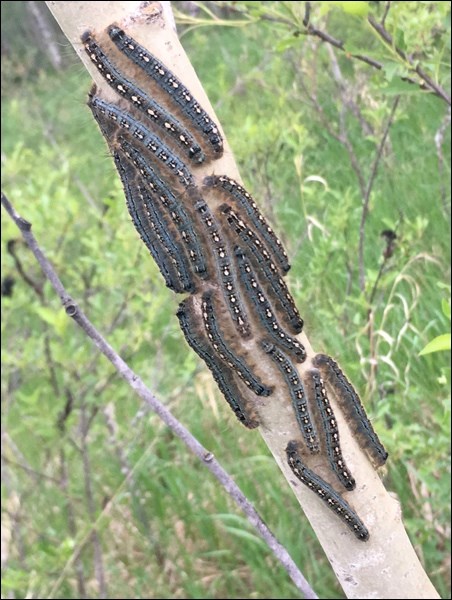The season of the forest tent caterpillar invasion isn’t over yet.
As the population of these little darlin’s continues to grow in each of the last few years, you can take comfort in the fact that we haven’t had a significant infestation of these critters since the 1990s, and although there seems to a lot of them, their numbers are still not as high as they were in the ‘90s, at least not yet.
The Cycle of Life
Forest tent caterpillar have only one generation per year. That’s great as once these caterpillars are gone, (this will be very soon) there will be no more forest tent caterpillars this season. Caterpillars hatch from an egg band laid the previous year and hatch about the same time the aspen buds are expanding in late April and early May. These caterpillars or larva will feed on tree leaves and other leaves until they are about 2.5 inches long. This usually takes until around mid June. The next stage in the development of this pest is a rest phase called pupation. This is where the larva spins a cocoon. They do this wherever they can.
Inside that cocoon, there is no rest for the wicked as the amazing transformation of a leaf eating larva to not a beautiful butterfly (like Heimlich in a Bug’s Life), but a boring, kind of nondescript, brown moth takes place.
After about 10 days, the ugly moth will come out of that cocoon with only one thing on its mind. Mating. There will be lots and lots of ugly brown moths if there were lots and lots of caterpillars. The mated females lay eggs in bands around twigs and cover them with a protective coat called spumaline to help ensure the survival of the youngsters. These will hatch out next spring. So that’s it. The cycle of life carries on.
FAQ or not so FAQs
Will my trees releaf? Answer: Yes, almost always.
Does the feeding and defoliation hurt my trees? Answer: Yes, if the defoliation happens year after year. The tree will use energy to replace the leaves, but having to use stored energy to produce another set of leaves, reduces health and vigour and there can be some twig dieback and reduced growth as a result.
How long is the cycle of infestation? Answer: That depends on a lot of environmental conditions. An infestation can last a few years to many, many years.
How many eggs can a moth lay? Answer: Only about 150 to 200 eggs are laid. Arggghhh!
When is the proper time to try doing some control? Answer: Only at the caterpillar larval stage and not at the moth stage.
Is there a product to use for control that is not harmful to pollinating insects like bees? Answer: Yes. Google - Bt var. k.



